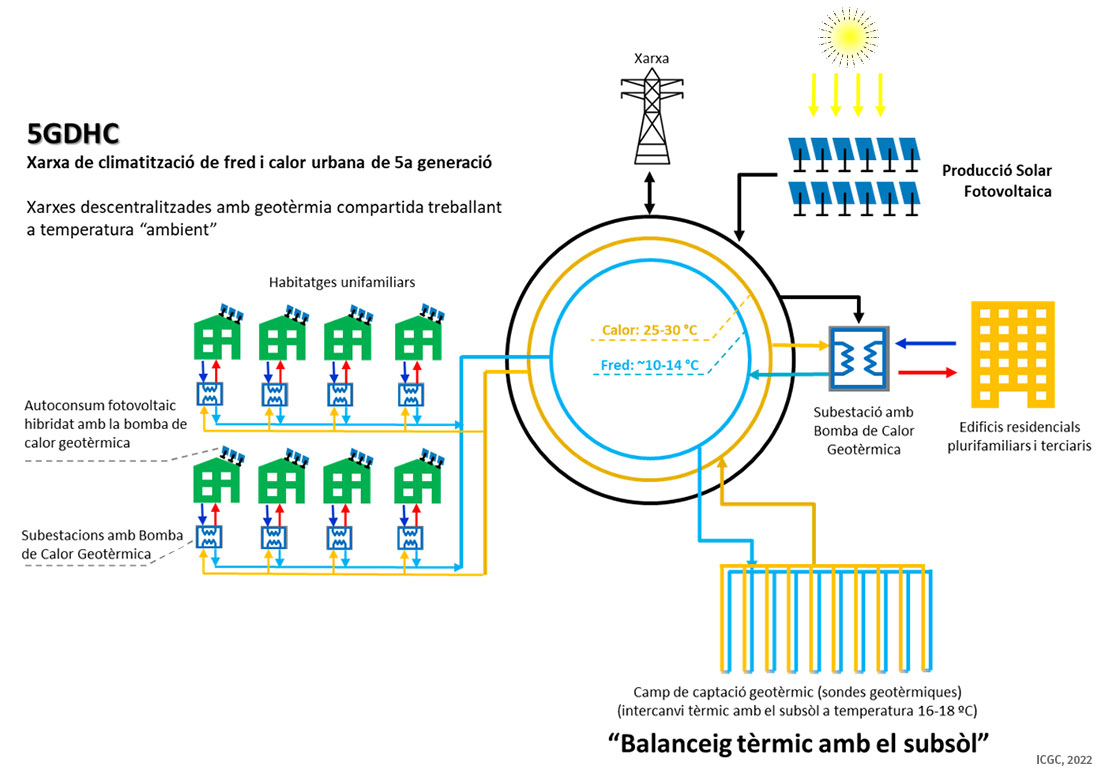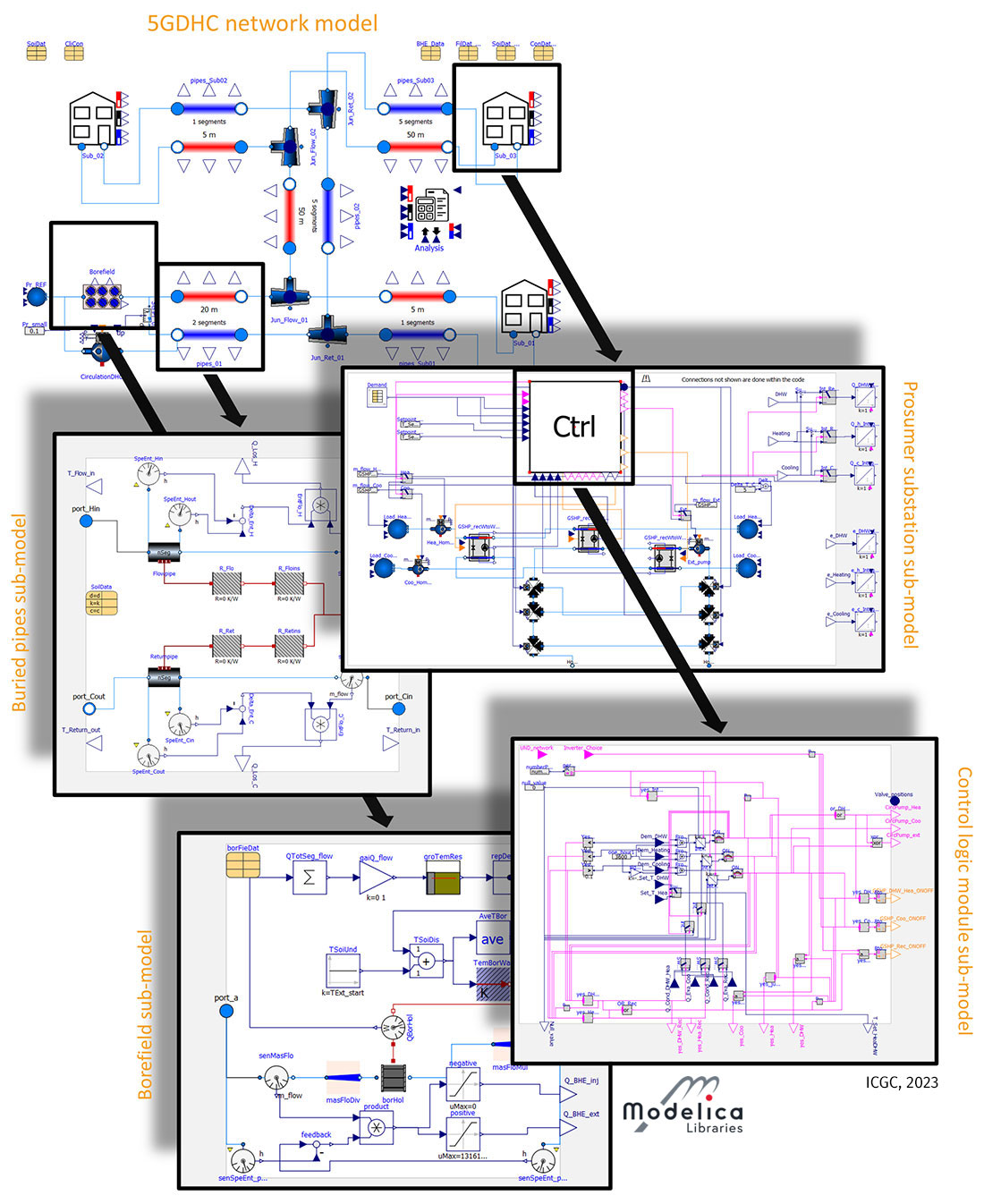
Concept of 5th generation district heating and cooling network (ICGC, 2022; modified from Garcia-Céspedes, et al., 2022)
Framework of the MA-DHC project
Considering the final energy consumption of the EU, 40% corresponds to the building sector, which represents 36% of greenhouse gas emissions. From a different perspective, 50% of energy end uses are for heating and cooling, where the building sector represents the 80%.
In order to achieve climate neutrality in 2050 in the EU territory, in accordance with its long-term strategy, it is necessary to promote in this sector an increase in its energy efficiency and a massive use of renewable energies, and in particular, of thermal renewable energy.
Besides, the effects of climate change are also leading to a progressive increase in cooling needs in the building stock, especially in Mediterranean countries and temperate climates.
Up to 50% of the demand for cold and heat in the EU could be generated under the scheme of district heating, cooling and domestic hot water (DHW) networks by 2050. For this reason, one of the key technologies that Europe is promoting to achieve its decarbonisation goals and to fight against climate change are smart, flexible and optimized low and very low temperature district networks, also known as 4th and 5th generation district heating and cooling networks (4GDHC and 5GDHC networks, respectively). These networks will operate exclusively with local and 100% renewable sources, especially with efficient technologies such as the ground source heat pump (GSHP). Precisely, in densely populated areas, the 4GDHC and 5GDHC networks represent the best scenario for taking advantage of such a clean, efficient, available and local renewable thermal resource as shallow geothermal energy. This includes open-loop systems (use of thermal energy present in both surface and underground water masses) and closed-loop systems (use of thermal energy present in the subsoil), as well as underground thermal storage systems. In addition, modern district networks allow the combination of various renewable technologies at the same time, creating obvious synergies such as the hybridization of shallow geothermal energy with photovoltaic solar energy.
In order to assess the use of shallow geothermal resources and their application in efficient heating and cooling networks, it is necessary to create tools for a rapid modelling process. This should be used by technicians in the early phases of studies and projects, aiding further decision making involving the integration of 4GDHC or 5GDHC networks schemes in urban areas. Moreover, a strong didactic component is necessary in this type of tool to help raise society's awareness of the existence of shallow geothermal resources and their benefits.
Project progress (last update from November 2023)
Throughout the last year, and once the article Fifth-Generation District Heating and Cooling Networks Based on Shallow Geothermal Energy: A review and Possible Solutions for Mediterranean Europe (https://doi.org/10.3390/en16010147) was published, the project activity has focused on the generation of a dynamic model of 5GDHC networks based on shallow geothermal energy (SGE). This model has been implemented in MODELICA language by means of the OMEdit tool from the OpenModelica package, and using the Modelica Standard Library (version 4.0.0) and the Modelica Buildings Library (version 9.1.0). It is, therefore, a model built entirely on the basis of open source and free access tools. The main motivation for the use of dynamic models in the study of 5GDHC networks is their greater complexity compared to previous concepts of DHC networks. This complexity is mainly given by its distributed nature, which involves a bidirectional flow of thermal energy between the buildings (now considered as “prosumers”) and the energy source, and which depending on the design could also contemplate a bidirectional flow of the heat transfer fluid. Furthermore, the concept of an energy source as a unidirectional energy supplier (from the source to the consumers) becomes obsolete when compared to the new concept called Balance Unit (BU). The BU can operate either as an energy source or an energy sink (essential in new heating and cooling networks), but also as a reservoir for energy storage, both in the short and long term. In this sense, SGE is the renewable resource that best meets the definition of a BU applied to 5GDHC networks. The sizing and/or the scaling-up of a BU based on SGE would no longer be linked solely to the aggregate demand of buildings that are progressively connected to the grid. Under this new concept, the thermal interaction between the buildings themselves and with the network must also be taken into account.
The generated dynamic model consists of 3 main elements or submodels: the buried pipes, the prosumer substations and the borefields. Likewise, these submodels are composed of other elements (control logic module, heat pumps, recirculating pumps, subsoil models, etc.), establishing multiple levels of inheritance and guaranteeing a modular structure of the entire set. Altogether will help to understand the operation of a 5GDHC network thoroughly, its strengths and the challenges regarding its upcoming implementation in Mediterranean Europe locations. In this sense, the developed model will be very useful in the design of new 5GDHC networks, the pre-evaluation of the technical feasibility of the projects and even in the creation of digital twins of real systems. From a Geological Survey perspective, this model will allow the ICGC to create new geo-referenced data sets related to the exploitation of SGE through 5GDHC networks.
Finally, the work carried out so far should serve to validate the forthcoming models (static models) that will be part of the future 5GDHC network design and dimensioning tool. These models will be simpler in their fundamentals and architecture but also more efficient in terms of computing time and more elaborate in terms of user experience.

The model is structured in a modular and multi-level manner.
References

 Contact
Contact










